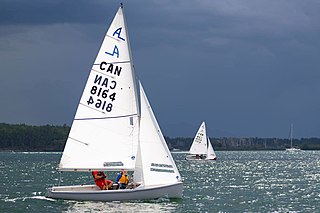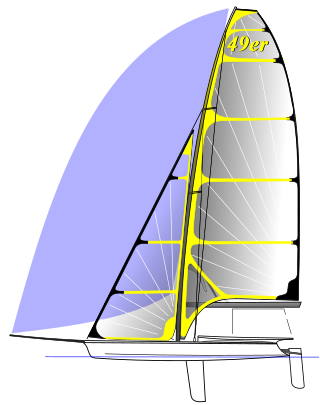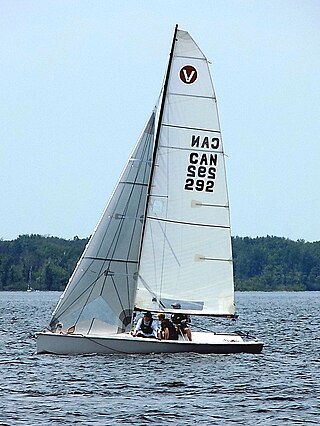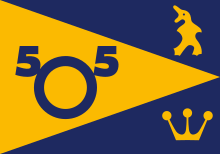
Dinghy sailing is the activity of sailing small boats by using five essential controls:

A jibe (US) or gybe (Britain) is a sailing maneuver whereby a sailing vessel reaching downwind turns its stern through the wind, which then exerts its force from the opposite side of the vessel. Because the mainsail boom can swing across the cockpit quickly, jibes are potentially dangerous to person and rigging compared to tacking. Therefore, accidental jibes are to be avoided while the proper technique must be applied so as to control the maneuver. For square-rigged ships, this maneuver is called wearing ship.

Dinghy racing is a competitive sport using dinghies, which are small boats which may be rowboats, have an outboard motor, or be sailing dinghies. Dinghy racing has affected aspects of the modern sailing dinghy, including hull design, sail materials and sailplan, and techniques such as planing and trapezing.

The Albacore is a 4.57 m (15 ft) two-person planing dinghy with fractional sloop rig, for competitive racing and lake and near-inshore day sailing. Hulls are made of either wood or fiberglass. The basic shape was developed in 1954 from an Uffa Fox design, the Swordfish. Recent boats retain the same classic dimensions, and use modern materials and modern control systems.

Running rigging is the rigging of a sailing vessel that is used for raising, lowering, shaping and controlling the sails on a sailing vessel—as opposed to the standing rigging, which supports the mast and bowsprit. Running rigging varies between vessels that are rigged fore and aft and those that are square-rigged.

The 49er and 49er FX is a two-handed skiff-type high-performance sailing dinghy. The two crew work on different roles with the helm making many tactical decisions, as well as steering, and the crew doing most of the sail control. Both of the crew are equipped with their own trapeze and sailing is done while cantilevered over the water to the fullest extent to balance against the sails.

The Firefly is a British sailboat that was designed by Uffa Fox as a one design racer and first built in 1946. The boat was originally named the Sea Swallow. It was an Olympic class and raced at the 1948 Olympics.

The Fireball is a British sailing dinghy that was designed by Peter Milne as a one-design racer and first built in 1962.

The Jet 14 is an American sailing dinghy that was designed by Howard Siddons as a one-design racer and first built in 1952.

The Sonar is a one design trailerable racing sailboat that was designed by Canadian naval architect Bruce Kirby and first built in 1980.

The International 14 is a British racing sailboat, crewed by two sailors. The class was established in 1928.
The P-Class is a type of small single sail dinghy, popular as a training boat for young people in New Zealand. This class is famous for being the sailing trainer vessel for many new entrants into the sport, and virtually every famous New Zealand yachtsman, including Sir Peter Blake and Russell Coutts, learnt to sail in one. The P-Class was for many years the most common sailing boat in New Zealand.

The Laser 3000 is a racing sailing dinghy crewed by two persons with a trapeze for the crew. Launched in 1996, the 3000 was developed from the Laser 2, using the original Frank Bethwaite-designed planing hull combined with a brand new self-draining deck by Derek Clark. Clark also re-designed the rig, using spars and sails from premium proprietary sources and replacing the symmetric spinnaker of the Laser 2 by a larger asymmetrical spinnaker. The gennaker is chute-launched and retrieved using a single halyard line, and is set on a retractable bowsprit. Helm balance and handling were improved using a shorter-footed mainsail with two full-width battens giving a larger roach. A mast with conventional spreaders replaced the now-unusual diamond arrangement of the Laser 2.
A 16 ft Skiff is a class of three-person sailing dinghy with twin trapezes and a large asymmetrical spinnaker. The class is unique to Australia, where it is one of the most popular boats sailing with 95 boats registered in 12 clubs. The class has the largest fleet of high performance skiffs on the east coast of Australia. Due to the nature of only allowing two trapezes, the age of the sailors can vary between 15 and 60 years old, making it a versatile class of boat.

The Hobie Tiger or Hobie Tiger 18, is a French catamaran sailboat that was designed by Hobie Cat Europe as a Formula 18 racer and first built in 1995.
The Skate is a high performance two-person racing dinghy unique to Australia. Designed as a monohull sailboat it's fourteen feet long (4.27m) with a 7.2m mast, 1.8m bow pole and masthead asymmetrical spinnaker. It is an Australian national class.
The following outline is provided as an overview of and topical guide to sailing:
John Westell was an English sailboat designer, who is noted for designing the 505 sailing dinghy and the Ocean Bird class of trimarans. Westell also designed cruising sailboats.

The Viper 640 is an American trailerable sailboat, that was designed by Brian Bennett for racing and first built in 1996.
The Beneteau First 14, originally the Seascape 14, is a French one design planing sailing dinghy that was designed by Samuel Manuard as a racer and first built in 2017.

















